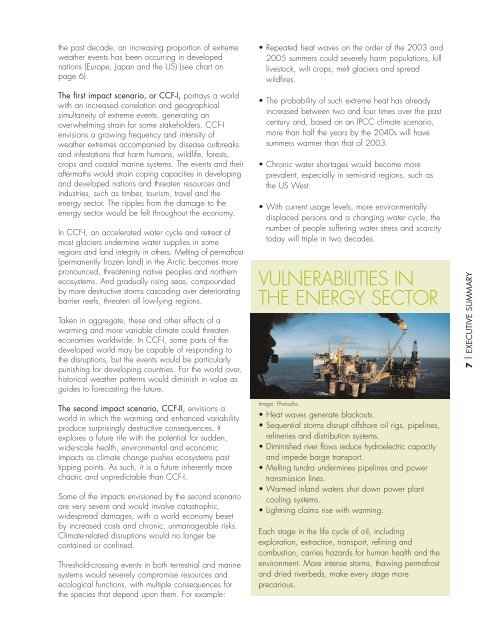Climate change futures: health, ecological and economic dimensions
Climate change futures: health, ecological and economic dimensions
Climate change futures: health, ecological and economic dimensions
You also want an ePaper? Increase the reach of your titles
YUMPU automatically turns print PDFs into web optimized ePapers that Google loves.
the past decade, an increasing proportion of extreme<br />
weather events has been occurring in developed<br />
nations (Europe, Japan <strong>and</strong> the US) (see chart on<br />
page 6).<br />
The first impact scenario, or CCF-I, portrays a world<br />
with an increased correlation <strong>and</strong> geographical<br />
simultaneity of extreme events, generating an<br />
overwhelming strain for some stakeholders. CCF-I<br />
envisions a growing frequency <strong>and</strong> intensity of<br />
weather extremes accompanied by disease outbreaks<br />
<strong>and</strong> infestations that harm humans, wildlife, forests,<br />
crops <strong>and</strong> coastal marine systems. The events <strong>and</strong> their<br />
aftermaths would strain coping capacities in developing<br />
<strong>and</strong> developed nations <strong>and</strong> threaten resources <strong>and</strong><br />
industries, such as timber, tourism, travel <strong>and</strong> the<br />
energy sector. The ripples from the damage to the<br />
energy sector would be felt throughout the economy.<br />
In CCF-I, an accelerated water cycle <strong>and</strong> retreat of<br />
most glaciers undermine water supplies in some<br />
regions <strong>and</strong> l<strong>and</strong> integrity in others. Melting of permafrost<br />
(permanently frozen l<strong>and</strong>) in the Arctic becomes more<br />
pronounced, threatening native peoples <strong>and</strong> northern<br />
ecosystems. And gradually rising seas, compounded<br />
by more destructive storms cascading over deteriorating<br />
barrier reefs, threaten all low-lying regions.<br />
Taken in aggregate, these <strong>and</strong> other effects of a<br />
warming <strong>and</strong> more variable climate could threaten<br />
economies worldwide. In CCF-I, some parts of the<br />
developed world may be capable of responding to<br />
the disruptions, but the events would be particularly<br />
punishing for developing countries. For the world over,<br />
historical weather patterns would diminish in value as<br />
guides to forecasting the future.<br />
The second impact scenario, CCF-II, envisions a<br />
world in which the warming <strong>and</strong> enhanced variability<br />
produce surprisingly destructive consequences. It<br />
explores a future rife with the potential for sudden,<br />
wide-scale <strong>health</strong>, environmental <strong>and</strong> <strong>economic</strong><br />
impacts as climate <strong>change</strong> pushes ecosystems past<br />
tipping points. As such, it is a future inherently more<br />
chaotic <strong>and</strong> unpredictable than CCF-I.<br />
Some of the impacts envisioned by the second scenario<br />
are very severe <strong>and</strong> would involve catastrophic,<br />
widespread damages, with a world economy beset<br />
by increased costs <strong>and</strong> chronic, unmanageable risks.<br />
<strong>Climate</strong>-related disruptions would no longer be<br />
contained or confined.<br />
Threshold-crossing events in both terrestrial <strong>and</strong> marine<br />
systems would severely compromise resources <strong>and</strong><br />
<strong>ecological</strong> functions, with multiple consequences for<br />
the species that depend upon them. For example:<br />
• Repeated heat waves on the order of the 2003 <strong>and</strong><br />
2005 summers could severely harm populations, kill<br />
livestock, wilt crops, melt glaciers <strong>and</strong> spread<br />
wildfires.<br />
• The probability of such extreme heat has already<br />
increased between two <strong>and</strong> four times over the past<br />
century <strong>and</strong>, based on an IPCC climate scenario,<br />
more than half the years by the 2040s will have<br />
summers warmer than that of 2003.<br />
• Chronic water shortages would become more<br />
prevalent, especially in semi-arid regions, such as<br />
the US West.<br />
• With current usage levels, more environmentally<br />
displaced persons <strong>and</strong> a changing water cycle, the<br />
number of people suffering water stress <strong>and</strong> scarcity<br />
today will triple in two decades.<br />
VULNERABILITIES IN<br />
THE ENERGY SECTOR<br />
Image: Photodisc<br />
• Heat waves generate blackouts.<br />
• Sequential storms disrupt offshore oil rigs, pipelines,<br />
refineries <strong>and</strong> distribution systems.<br />
• Diminished river flows reduce hydroelectric capacity<br />
<strong>and</strong> impede barge transport.<br />
• Melting tundra undermines pipelines <strong>and</strong> power<br />
transmission lines.<br />
• Warmed inl<strong>and</strong> waters shut down power plant<br />
cooling systems.<br />
• Lightning claims rise with warming.<br />
Each stage in the life cycle of oil, including<br />
exploration, extraction, transport, refining <strong>and</strong><br />
combustion, carries hazards for human <strong>health</strong> <strong>and</strong> the<br />
environment. More intense storms, thawing permafrost<br />
<strong>and</strong> dried riverbeds, make every stage more<br />
precarious.<br />
7 | EXECUTIVE SUMMARY

















